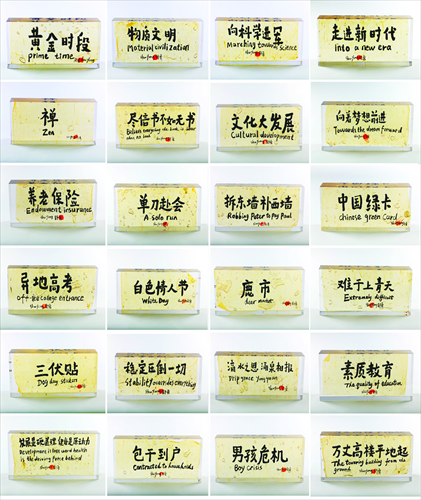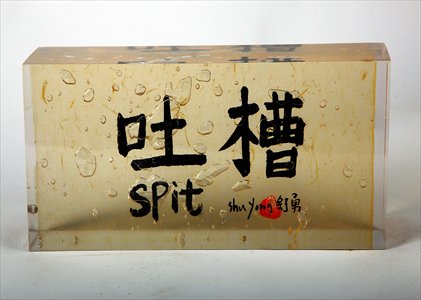Artistic license


Shu Yong's Guge Bricks show popular Chinese online phrases with their English translation according to Google. Photos: Courtesy of Wang Chunchen
The 55th Venice Biennale is scheduled for June 1 to November 24. However, the discussions about the event, regarding this year's theme, what artists to include and the design of the Chinese pavilion started at the beginning of this year.
China has taken part in the Venice Biennale for eight years now. Although it is not a long time compared to the event's 120-year history, the Chinese pavilion has attracted attention and stirred up discussion from year to year.
This time, the director Massimiliano Gioni's theme, The Encyclopedic Palace, gives more free space for international artists. Inspired by Italian-American artist Marion Auriti's concept of an encyclopedic museum created in 1955, the theme breaks the boundary of the art we are familiar with, allowing all kinds of innovations in arts to be involved.
Gioni said during the press conference held in October last year that "It's the crazy dream, bordering between knowledge and madness, image and imagination."
Transforming image
On the Chinese side, a big breakthrough was a new space for the pavilion. In past years, the pavilion was filled with huge oil drums, leaving limited space for the artists.
As those drums were part of Venice's industrial history, Chinese artists who participated in the Biennale created artworks based on the "oilcan spaces."
This March, with help from China's Ministry of Culture and other supporting organizations, the oil drums were finally removed (with only one left) at a cost of almost $300,000.
In February, among all the submitted plans, Wang Chunchen's Transfiguration stood out to be selected as the theme of the Chinese pavilion.
Wang, an associate professor from China Central Academy of Fine Arts, borrowed the term from The Transfiguration of the Commonplace (1984), written by American philosopher and art theorist Arthur Danto, to review the changes of Chinese art as well as the Chinese society in its 30 years of contemporary art development.
Wang explained that "transfiguration" was originally a religious term but was later used broadly in a similar way as "transformation." He added that the word here also refers to the surpassing of the gap between life and art and also echoes the ongoing changes of the contemporary international society.
"The proposition of Chinese art is no longer a one-way street but also intertwines and conveys how the Chinese perceive the world," Wang wrote in his introduction of Chinese pavilion.
At the end of April, Wang and the seven artists he selected released their full project plan through a press conference at which each artist introduced their work to the public.
Multimedia presentation
For the space outside the Chinese pavilion there will be three installations. The Water of Venice by He Yunchang presents 2,013 glass bottles filled with water, and each has a tag of a number and the artist's signature. In the scene there will also be water provided for the audience to fill their own container and write their own names on a new tag to exchange with the artist's bottle. The work aims to bring a sense of sharing and communication in a global society.
Hu Yaolin has been a controversial artist since he was selected to be one of the seven going to Venice, because he is not technically an artist. Hu is a culturist and for years has worked on the preservation of old Chinese buildings. This time, he is going to bring an architectural installation to Venice: Thing-in-itself, which recalls the memories of traditional culture and heritage.
Shu Yong's Guge Bricks printed popular online Chinese phrases on special bricks he made. Every brick also has its English translation copied directly from the Google translation. The work presents Chinese issues with an international vision. It also reviews the Bible between different cultures through the clunky or sometimes nonsensical translations. The form reflects distinct characteristics of the era.
Inside the pavilion will be Miao Xiaochun's new digital art project, Tong Hongsheng's paintings of still items, Wang Qingsong's tableau photography and Zhang Xiaotao's animation.
Contemporary art in China is multidimensional. The selected artists and their works open up discussions of the artists' sometimes blurred identity and the question of what contemporary art truly is. The multiple possibilities of art expression presented in these works also correspond to both the Transfiguration theme and the Biennale theme The Encyclopedic Palace.
Fan Di'an, curator of the National Art Museum of China, said at the press conference that the fact that most of the works were not specially created for the Venice trip but rather were selected from the artist's existing work reflects the changed relationship between Chinese artist's creations and international exhibitions. Chinese artists today are not restricted to any set answers like before. They are more free and independent.
The changing view
Alongside the official Biennale there are also many parallel exhibitions that accept applications from artists. As a result, many Chinese artists are going to spend their summer in Venice.
Wang said that although these exhibitions have nothing to do with the Chinese pavilion, they all represent part of what is happening in China's art world today.
Chinese people in general used to have an extremely serious attitude when it came to international events or competitions such as the Oscars, Nobel prizes, Olympic Games or the Venice Biennale.
Since there are more opportunities opening up for Chinese artists now, some have started to doubt the prestige of the Venice Biennale and the value of spending so much effort to participate.
Fan said that industry insiders in China now often hold complicated emotions towards the Venice Biennale: a bit love, a bit hate and a bit vexed.
"Every time we search the general characteristics of world art, we see the Biennale's position as a platform for building up dialogues. Does the world really understand Chinese art? Artists are not coming to Venice as celebrities to represent the whole of China, but they do represent an essential part of Chinese art. They need to be surefooted," said Fan.